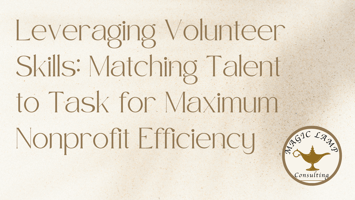Volunteers are the lifeblood of nonprofit organizations, offering their time and expertise to...
How to Set Clear Expectations for Volunteers: Role Descriptions and Accountability

Volunteers are the backbone of many nonprofits, bringing passion, energy, and skills to help advance a mission. However, without clear expectations, their efforts can become disorganized, leading to frustration for both the volunteers and the organization. Setting clear role descriptions and establishing accountability ensures that volunteers feel valued, understand their responsibilities, and contribute effectively. Here’s how nonprofit leaders can create a structured and successful volunteer experience.
1. Define the Purpose of the Volunteer Role
Before recruiting volunteers, nonprofit leaders should clearly define why the role exists and how it contributes to the organization’s mission. Each volunteer position should align with strategic goals and serve a specific purpose. Ask these questions:
- What need does this role fill within the organization?
- How does it support staff and other volunteers?
- What impact will the volunteer’s work have on the community?
Having a well-defined purpose ensures that volunteers understand their contributions and feel motivated to stay engaged.
2. Create Detailed Volunteer Role Descriptions
A well-crafted role description provides volunteers with clarity on what’s expected of them. It should include:
- Title: A clear and professional title, such as “Social Media Volunteer” or “Event Support Coordinator.”
- Overview: A brief summary of the role and its significance to the organization.
- Key Responsibilities: A detailed list of tasks the volunteer will be expected to perform.
- Time Commitment: Specify the expected hours per week/month and whether it’s a short-term or ongoing role.
- Qualifications and Skills: Any necessary experience, training, or skills required.
- Supervision and Support: Clarify who the volunteer reports to and what resources will be available.
- Benefits of the Role: Include any training, networking opportunities, or professional development benefits volunteers may receive.
By providing this level of detail, you set volunteers up for success and help them determine if the role is a good fit for their abilities and availability.
3. Communicate Expectations Clearly
Once a role description is created, it’s important to communicate expectations early and often. During onboarding, have a conversation about:
- Organizational values and culture.
- Specific goals and objectives for the volunteer’s work.
- Boundaries and limitations—what they should and shouldn’t do.
- Protocols for communication and reporting progress.
Using written agreements or handbooks can further solidify expectations and serve as reference materials for volunteers.
4. Provide Proper Training and Resources
Even the most skilled volunteers need guidance to integrate into your organization effectively. A structured training program helps them gain confidence in their roles. Training should cover:
- The mission and history of the nonprofit.
- The specific tasks and responsibilities of their role.
- The tools and resources they will be using.
- Emergency procedures or organizational policies they need to follow.
Ongoing training opportunities can keep volunteers engaged and help them develop new skills.
Related Blog: 7 Strategies for Nonprofits to Effectively Manage Their Volunteers
5. Establish Accountability Structures
Accountability ensures that volunteers remain committed and perform their roles effectively. Here’s how you can create a positive accountability system:
- Regular Check-Ins: Schedule meetings or check-ins to offer support, answer questions, and assess progress.
- Performance Feedback: Provide constructive feedback on what they’re doing well and where they can improve.
- Recognition and Rewards: Celebrate volunteers' contributions through appreciation events, shout-outs, or small incentives.
- Conflict Resolution: Address any challenges or misunderstandings promptly to maintain a positive volunteer experience.
When volunteers understand that accountability is about mutual respect and support, they are more likely to stay engaged and perform their roles effectively.
6. Encourage Open Communication
Volunteers should feel comfortable voicing concerns, asking for help, or suggesting ideas. Encourage open communication by:
- Assigning a staff member or experienced volunteer as a mentor or point of contact.
- Creating a space (such as a private online forum or regular meetings) where volunteers can share their experiences.
- Actively listening and responding to volunteer feedback to improve the program.
A culture of open communication fosters trust and strengthens volunteer commitment.
7. Evaluate and Adjust Roles as Needed
Volunteer roles should evolve to meet both organizational needs and volunteer capabilities. Periodically review roles by:
- Gathering feedback from volunteers about their experiences.
- Assessing whether tasks align with the nonprofit’s changing priorities.
- Modifying role descriptions or responsibilities to better serve both the organization and its volunteers.
This adaptability ensures long-term sustainability and keeps volunteers engaged in meaningful work.
Our Final Thoughts
Setting clear expectations for volunteers through well-defined roles and accountability measures not only strengthens your nonprofit’s operations but also enhances the volunteer experience. By investing time in structuring roles, providing support, and fostering open communication, nonprofit leaders can build a dedicated, motivated, and effective volunteer team. When volunteers know what’s expected of them and feel valued, they are more likely to stay committed and make a lasting impact on your mission.




